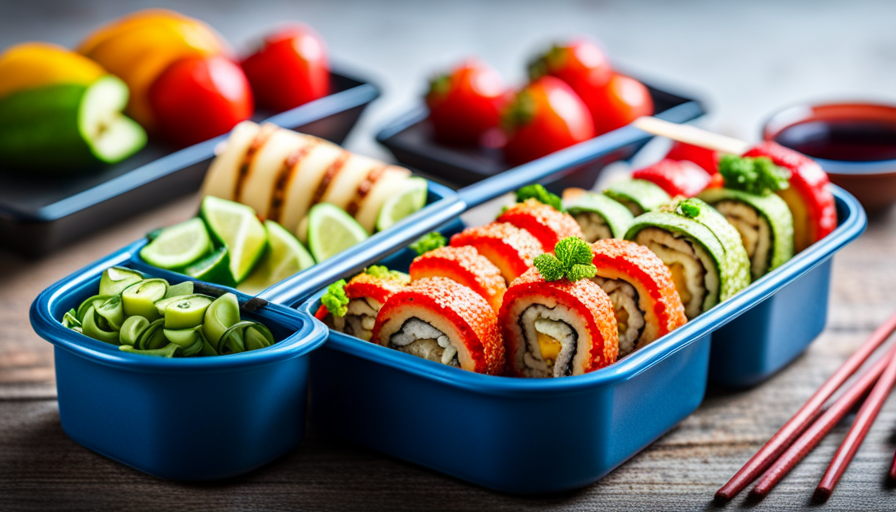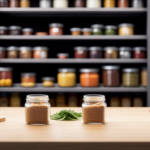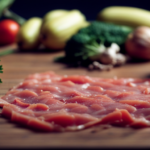Food is more than just something that keeps us going; it’s an adventure that stimulates all of our senses. As someone who cooks professionally, I view preparing meals as a creative expression that enables me to craft delicious works of art. Yet, within the excitement and innovation of the culinary realm, there lies a clandestine threat that can jeopardize our well-being – cross-contamination. Much like a stealthy assassin, it can hide in our kitchens, leading to foodborne illnesses with serious repercussions.
That’s why it is crucial to understand the importance of using separate utensils when handling raw and cooked food items. By doing so, we can prevent the transfer of harmful bacteria and keep our meals safe and delicious.
In this article, I will explore the risks of cross-contamination, provide tips for implementing separate utensils, and debunk common myths surrounding this topic. Let’s dive into the world of food safety and ensure that every bite we take is a delightful and safe one.
Key Takeaways
- Using separate utensils when handling raw and cooked food items reduces the risk of cross-contamination and prevents the transfer of harmful bacteria.
- Separate utensils help preserve the flavor and texture of cooked dishes.
- Using different cutting boards for fruits, vegetables, and raw meats is essential in preventing cross-contamination.
- Proper handwashing before and after handling utensils is crucial for food safety.
Understanding the Risks of Cross-Contamination
You need to understand the risks of cross-contamination so you don’t end up with a stomach ache from eating raw chicken. Cross-contamination occurs when bacteria from one food item are transferred to another, potentially leading to foodborne illnesses.
The risks of cross-contamination are significant, as it can result in severe gastrointestinal problems, such as vomiting, diarrhea, and abdominal pain. By using separate utensils when handling raw and cooked food items, you can minimize the chances of cross-contamination and protect yourself from these risks.
Using separate utensils is of utmost importance because it prevents the transfer of harmful bacteria from raw foods to cooked foods. Raw meats, such as chicken, can contain bacteria like Salmonella or Campylobacter, which can cause serious illnesses when consumed. If these bacteria come into contact with cooked foods, they can multiply and pose a health hazard. By using separate utensils, you can avoid this risk and ensure that your cooked foods remain safe for consumption.
Understanding the risks of cross-contamination and the importance of using separate utensils is crucial for maintaining food safety. By taking these precautions, you can protect yourself and your loved ones from the potential harm caused by contaminated foods. With this knowledge, let’s explore the importance of using separate utensils in more detail.
Importance of Using Separate Utensils
When it comes to preparing meals, it’s crucial to remember that maintaining a clear distinction between the tools you use can safeguard against potential cross-contamination risks. One important aspect of this is using separate utensils for handling raw and cooked food items.
There are several tips for organizing your utensils to ensure this separation. One effective method is to use color-coded utensils, where each color represents a specific type of food or task. For example, you can designate red utensils for raw meat and green utensils for cooked vegetables. This system not only helps prevent cross-contamination but also makes it easier to identify the right utensil for each job.
Using separate utensils has numerous benefits. Firstly, it reduces the chances of harmful bacteria from raw foods contaminating cooked foods. This is especially important for individuals with weakened immune systems, such as young children and the elderly. Secondly, it helps maintain the flavors and textures of different dishes. Imagine using the same spoon to stir a raw egg mixture and then a delicate sauce – the flavors would mix, resulting in a less enjoyable meal. Lastly, separate utensils make cleaning and sanitizing easier, as you can focus on specific utensils and eliminate any potential residual bacteria.
In the next section, I will provide some helpful tips for implementing separate utensils in your kitchen routine. By following these guidelines, you can ensure the safety and quality of your meals without compromising on taste or convenience.
Tips for Implementing Separate Utensils
Embrace the power of vibrant colors in your kitchen, assigning each hue to a specific culinary task, and watch as your meals come alive with safety and flavor. When it comes to organizing utensils, using separate ones for raw and cooked food items is a game-changer. Not only does it prevent cross-contamination, but it also ensures that your meals are safe to consume. Here are some tips for implementing separate utensils in your kitchen.
| Color | Raw Food | Cooked Food |
|---|---|---|
| Red | Raw meat | Cooked meat |
| Green | Raw vegetables | Cooked vegetables |
| Blue | Raw seafood | Cooked seafood |
| Yellow | Raw poultry | Cooked poultry |
By assigning specific colors to each category, you can easily identify which utensil to use for a particular task. This system not only simplifies your cooking process but also adds a touch of fun to your kitchen. The benefits of using separate utensils are numerous. It reduces the risk of foodborne illnesses, preserves the flavor of your dishes, and gives you peace of mind knowing that you are preparing meals in a hygienic environment.
Now that you have mastered the art of organizing utensils, let’s move on to the next step: using different cutting boards.
Using Different Cutting Boards
When it comes to food safety, one of the key points to consider is avoiding cross-contamination of fruits, vegetables, and raw meats. This can be achieved by using different cutting boards for each type of food.
Additionally, choosing the right cutting board materials is crucial in preventing the growth and spread of bacteria.
Avoiding cross-contamination of fruits, vegetables, and raw meats
To prevent cross-contamination of fruits, vegetables, and raw meats, it’s crucial to use separate utensils. Here are four key points to understand the risks of cross-contamination and prevent it effectively:
-
Always wash your hands thoroughly before and after handling raw meats, fruits, and vegetables. This helps eliminate any bacteria that may be present on your hands.
-
Use different cutting boards for raw meats and fruits/vegetables. This reduces the chances of bacteria from raw meats transferring onto the produce, which can lead to foodborne illnesses.
-
Keep raw meats separate from fruits and vegetables in the refrigerator. Store them in separate containers or use plastic bags to prevent any juices from contaminating the produce.
-
Clean and sanitize your utensils and cutting boards properly after each use. This ensures that any lingering bacteria or contaminants are eliminated.
By following these practices, you can minimize the risk of cross-contamination and ensure the safety of your meals.
Now let’s discuss the importance of choosing the right cutting board materials.
Choosing the right cutting board materials
Now that we understand the importance of avoiding cross-contamination between fruits, vegetables, and raw meats, let’s delve into the next crucial aspect of food safety: choosing the right cutting board materials.
Proper cutting board maintenance is essential to prevent the growth and spread of harmful bacteria. Wooden cutting boards are a popular choice due to their natural antimicrobial properties, but they require regular cleaning and oiling to keep them in good condition. Alternatively, plastic cutting boards are non-porous and easier to clean, making them a practical option.
Additionally, selecting the right knives for the task at hand is vital. Different types of knives are designed for specific uses, such as chopping, slicing, or filleting. By using the appropriate cutting board materials and knives, we can minimize the risk of cross-contamination and ensure the safety of our food.
Now, let’s move on to the next section on utensil safety and handling.
Utensil Safety and Handling
Using separate utensils for raw and cooked food is like building a culinary fortress, protecting against cross-contamination. Proper utensil storage and handling are crucial to ensure food safety in the kitchen.
When storing utensils, it’s important to keep raw and cooked utensils separate to prevent the transfer of harmful bacteria. Raw utensils should be stored away from cooked utensils to avoid any potential cross-contamination.
In addition to proper storage, proper handwashing is essential when handling utensils. Before using any utensils, it’s important to wash your hands thoroughly with soap and warm water. This helps to prevent the transfer of bacteria from your hands to the utensils and ultimately to the food. Handwashing should also be practiced after handling raw food and before touching cooked food or utensils.
By following these guidelines for utensil storage and proper handwashing, you can minimize the risk of cross-contamination and ensure the safety of your meals. It’s crucial to educate others on the importance of separate utensils to prevent foodborne illnesses. By spreading awareness and sharing knowledge, we can all contribute to a safer and healthier kitchen environment.
Educating Others on the Importance of Separate Utensils
By spreading awareness about the culinary fortress of using different tools for different purposes, we can all contribute to a safer and healthier kitchen environment. Understanding cross-contamination risks is crucial in maintaining food safety standards. When raw and cooked food items come into contact with the same utensils, the potential for harmful bacteria to spread increases significantly. This can lead to foodborne illnesses and pose a serious threat to our health.
Implementing separate utensils for raw and cooked food items is a simple yet effective way to prevent cross-contamination. It ensures that bacteria from raw foods, such as poultry or seafood, don’t come into contact with cooked foods, like vegetables or grains. By using separate utensils, we can minimize the risk of foodborne illnesses and keep our kitchen clean and safe.
Educating others on the importance of separate utensils is vital. We must emphasize the potential dangers of cross-contamination and the role that utensils play in preventing it. By raising awareness and sharing our knowledge, we can empower others to adopt this practice and create a culture of safe food handling.
Transitioning into the subsequent section about the role of utensils in food safety regulations, it’s essential to understand that separate utensils aren’t just a personal preference, but a requirement in many professional kitchens. These regulations are in place to ensure that food is safely prepared and consumed, further highlighting the importance of using separate utensils.
The Role of Utensils in Food Safety Regulations
To ensure a safe and healthy kitchen environment, it’s crucial that you understand and comply with the food safety regulations regarding the proper use of kitchen tools. Utensils play a vital role in maintaining food safety by preventing cross contamination and ensuring utensil sanitation.
Here are three important aspects of food safety regulations related to utensils:
-
Separate utensils for raw and cooked foods: Using separate utensils for raw and cooked food items is essential in preventing the transfer of harmful bacteria. Raw meats, poultry, and seafood can contain pathogens such as Salmonella or E. coli, which can contaminate cooked foods if the same utensils are used. It is important to keep separate cutting boards, knives, and other utensils for handling raw and cooked foods.
-
Proper cleaning and sanitation: Utensils must be thoroughly cleaned and sanitized after each use to eliminate any potential bacteria. This includes washing utensils with hot, soapy water and drying them properly. Additionally, it’s recommended to sanitize utensils by using a sanitizing solution or by running them through a dishwasher.
-
Avoiding cross contamination: Cross contamination can occur when utensils are used interchangeably between different food items without proper cleaning. For example, using a spatula to flip raw meat and then using it to serve cooked food can lead to cross contamination. It’s important to use different utensils or wash them thoroughly between uses to prevent this.
By following these food safety regulations regarding utensil usage, you can significantly reduce the risk of foodborne illnesses caused by cross contamination.
In the next section, we’ll address common myths and misconceptions related to utensil handling and food safety.
Common Myths and Misconceptions
When it comes to food safety, it’s important to debunk misconceptions about cross-contamination. Many people believe that washing utensils between handling raw and cooked food is unnecessary, but this is not true. Using separate utensils for raw and cooked food is crucial in preventing the spread of harmful bacteria.
Additionally, some individuals may have concerns about the extra utensil usage and its impact on the environment. However, it’s important to prioritize food safety over these concerns and take the necessary precautions to ensure the health and well-being of ourselves and others.
Debunking misconceptions about cross-contamination
Avoiding cross-contamination is crucial in the kitchen, so don’t believe the myth that using the same utensils for raw and cooked food is harmless – it’s like playing Russian roulette with your health. Here are four reasons why separate utensils are necessary:
-
Bacteria transfer: Raw food can contain harmful bacteria like salmonella or E. coli. If you use the same utensils to handle cooked food, these bacteria can easily transfer, leading to food poisoning.
-
Flavor contamination: Raw ingredients often have strong flavors that can overpower the taste of cooked food. By using separate utensils, you prevent the mingling of flavors and ensure each dish tastes as intended.
-
Allergen cross-contact: Some individuals have food allergies or sensitivities. Using separate utensils prevents allergens from coming into contact with dishes that should be allergen-free, reducing the risk of allergic reactions.
-
Food safety standards: Following food safety guidelines is crucial in professional kitchens. Using separate utensils is a standard practice that helps establishments meet these standards and maintain a high level of cleanliness.
By addressing these misconceptions and understanding the benefits of separate utensils, we can ensure safer and healthier meals.
Transitioning into the next section, let’s discuss addressing concerns about extra utensil usage.
Addressing concerns about extra utensil usage
Using different tools in the kitchen can actually enhance your cooking experience and make it more enjoyable. While some may argue that using separate utensils for raw and cooked food items is inconvenient and unnecessary, it’s important to consider the benefits it offers. Not only does it minimize the risk of cross-contamination and foodborne illnesses, but it also ensures the flavors of your dishes remain untainted.
Concerns about extra utensil usage can be addressed by choosing alternative solutions that are both practical and environmentally friendly. For example, using reusable silicone or stainless steel utensils instead of disposable ones can minimize environmental impact. By making this small change, you can protect your health, enhance your culinary skills, and contribute to a more sustainable future.
Transitioning into the subsequent section about additional food safety tips, it’s essential to be aware of other measures we can take to ensure the safety of our meals.
Additional Food Safety Tips
When it comes to food safety, proper storage of leftovers is crucial. I always make sure to refrigerate any leftover food within two hours of cooking to prevent bacteria growth.
Additionally, I’m meticulous about handling raw poultry and seafood. I wash my hands thoroughly after touching these items and use separate cutting boards and utensils to avoid cross-contamination.
Proper storage of leftovers
To ensure the safety and quality of your leftovers, it’s essential to store them properly. This includes considering factors such as temperature, airtight containers, and the separation of raw and cooked food items.
Proper storage is crucial to prevent bacterial growth and maintain the integrity of the food. After cooking, leftovers should be promptly cooled to a safe temperature, ideally below 40°F, and then transferred to airtight containers. This helps to maintain their freshness and prevent cross-contamination.
When reheating leftovers, it’s important to use proper techniques to ensure they are heated thoroughly. They should reach an internal temperature of 165°F to kill any potential bacteria.
By following these guidelines for proper storage and reheating, you can enjoy your leftovers safely.
Now, let’s move on to the next section about the safe handling of raw poultry and seafood.
Safe handling of raw poultry and seafood
Raw poultry and seafood require special care to ensure their safe handling and preservation of their delicate flavors. To reduce cross-contamination, it’s crucial to separate raw poultry and seafood from other food items.
Here are some safe handling techniques to keep in mind:
- Use separate cutting boards, utensils, and plates for raw poultry and seafood to avoid spreading harmful bacteria.
- Wash your hands thoroughly with soap and warm water before and after handling raw poultry and seafood.
- Store raw poultry and seafood in leak-proof containers on the bottom shelf of the refrigerator to prevent any drips onto other foods.
By following these practices, you can minimize the risk of foodborne illnesses and maintain the quality of your cooked dishes.
Moving forward to the conclusion and final thoughts, it’s important to always prioritize food safety to ensure the well-being of yourself and others.
Conclusion and Final Thoughts
In the end, it’s clear that using separate utensils for raw and cooked food items is the smart choice for a safer and more delicious cooking experience. Through the previous discussion on the safe handling of raw poultry and seafood, it becomes evident that cross-contamination can pose serious health risks. By using separate utensils, we can prevent the transfer of harmful bacteria from raw to cooked foods.
There are several conclusions to draw from this topic. Firstly, using separate utensils reduces the chances of foodborne illnesses caused by bacteria such as Salmonella and Campylobacter. Secondly, it helps maintain the integrity of flavors and textures in cooked dishes by avoiding the mixing of raw meat juices with cooked food. Lastly, it promotes good hygiene practices in the kitchen, ensuring that our meals are prepared in a clean and safe environment.
To summarize the benefits of separate utensils, I have created a table below:
| Benefits of Using Separate Utensils |
|---|
| Reduces the risk of foodborne illnesses |
| Preserves flavors and textures in cooked dishes |
| Promotes good hygiene practices in the kitchen |
Incorporating the use of separate utensils in our cooking routine is a simple yet effective way to enhance food safety and quality. By following this practice, we can enjoy our meals with confidence, knowing that we have taken the necessary steps to protect ourselves and our loved ones from potential health hazards.
Frequently Asked Questions
Are there any exceptions to using separate utensils for raw and cooked food items?
When it comes to safety precautions in the kitchen, there aren’t any exceptions to using separate utensils for raw and cooked food items. It’s like navigating through treacherous waters without a compass.
However, when handling seafood, it becomes even more critical. Seafood is particularly susceptible to contamination, and cross-contamination can lead to foodborne illnesses.
So, to ensure the utmost safety, always use separate utensils when handling raw and cooked food, especially seafood.
How often should utensils be cleaned and sanitized when handling raw and cooked food?
When handling raw and cooked food items, it’s crucial to properly clean and sanitize utensils to prevent cross-contamination. To ensure thorough cleaning, utensils should be washed with hot, soapy water after each use.
Additionally, using separate cutting boards for raw and cooked food items is important to avoid the transfer of harmful bacteria.
Regularly sanitizing utensils, such as by using a sanitizing solution or dishwasher, further reduces the risk of contamination and helps keep food safe for consumption.
Can using separate utensils prevent foodborne illnesses completely?
Using separate utensils when handling raw and cooked food items is an essential practice in preventing foodborne illnesses. However, it’s important to note that it alone can’t completely prevent such illnesses.
Along with this practice, proper food storage techniques play a crucial role in preventing the growth of harmful bacteria. Additionally, ensuring that food is cooked at the appropriate temperatures is vital to kill any potential pathogens.
By combining these measures, we can significantly reduce the risk of foodborne illnesses.
Are there any specific types of utensils that should be used for handling raw and cooked food?
Using the right utensils is crucial for food safety. When handling raw and cooked food, it’s important to use proper utensils to prevent cross-contamination and the spread of harmful bacteria.
For raw food, such as meat or fish, separate utensils like cutting boards and knives should be used.
Cooked food, on the other hand, can be handled with clean utensils. This simple practice greatly reduces the risk of foodborne illnesses and ensures the safety of your meals.
Can using separate utensils also prevent cross-contamination with allergens?
Using separate utensils for handling raw and cooked food items is not only important for preventing cross-contamination between them, but it can also help prevent cross-contamination with allergens. By using dedicated utensils for specific food items, the risk of allergen transfer is minimized.
Additionally, it’s crucial to thoroughly clean utensils after each use to remove any traces of allergens. Following proper food handling practices and maintaining a clean kitchen environment are key tips for preventing cross-contamination with allergens.
Should Different Utensils Be Used When Handling Raw and Cooked Foods at Fast Food Restaurants?
It is essential for fast food workers handling raw foods to use different utensils when preparing cooked and raw ingredients. This practice prevents cross-contamination and reduces the risk of foodborne illnesses. By using separate utensils, fast food restaurants can ensure the safety and quality of their food products.
Conclusion
In conclusion, it’s absolutely crucial to use separate utensils when handling raw and cooked food items. Just as a conductor skillfully directs an orchestra, our utensils play a vital role in ensuring food safety.
Like a delicate dance, they must gracefully move from one task to another, without ever mixing the two. By adhering to this simple yet powerful practice, we can prevent the risk of cross-contamination and protect ourselves and our loved ones from foodborne illnesses.
So let us be vigilant, keep our utensils separate, and savor the joy of safe and delicious meals.

















